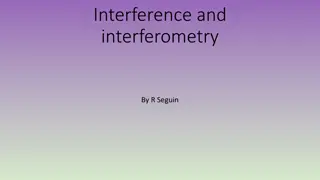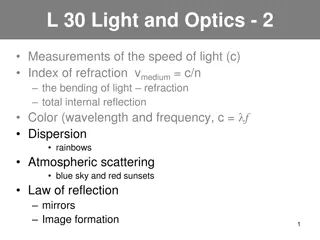The Fascinating World of Rainbows and How They Form
Explore the enchanting phenomenon of rainbows, from their formation when sunlight passes through raindrops to the beautiful spectrum of colors they display. Discover the science behind why rainbows appear, where they can be seen, and the symbolic significance they hold across different cultures. Delve into the stunning imagery and intriguing facts presented by Niamh Haresceugh Jones, a Year 6 student.
Download Presentation

Please find below an Image/Link to download the presentation.
The content on the website is provided AS IS for your information and personal use only. It may not be sold, licensed, or shared on other websites without obtaining consent from the author. Download presentation by click this link. If you encounter any issues during the download, it is possible that the publisher has removed the file from their server.
E N D
Presentation Transcript
How are rainbows formed? By Niamh Haresceugh Jones Yr 6
Rainbow Facts: Rainbow Facts: A rainbow is an arc of colour in the sky that can be seen when the sun shines through falling rain. The pattern of colors starts with red on the outside and changes through orange, yellow, green, blue, indigo to violet on the inside. A rainbow is created when light is bent (refracted) while entering a droplet of water and reflected. A rainbow is actually round. On the ground, the bottom part is hidden, but in the sky, like from a flying airplane, it can be seen as a circle. Rainbows often appear after storms, and are popular symbols for peace and harmony in many cultures.
Cause: Cause: The rainbow affect can be seen when: There are water drops in the air and the sun is giving light back of the observer at a low distance up or angle. shadow of your head (which is the point opposite the sun). Sunlight is white and is a mixture f many different colours. Water and other materials bend the different colours at different angles, some more strongly than others. This is called dispersion. By splitting up white light into separate colour, rainbows appear colorful even though the light hitting them is white. The rainbow displays with the deepest effect in our minds take place when: Half of the sky is still dark with draining clouds; and the observer is at a place with clear sky above. Another common place to see the rainbow effect is near waterfalls. Parts of rainbows can be seen some of the time: at the edges of clouds lit from the back; or as upright bands of spectrum in far away rain even if it does not fall on the earth. An unnatural rainbow effect can also be made by spraying drops of water into the air on a sunny day. Rainbows always appear opposite from the sun: they form circles around the
The seven colours of the rainbow The rainbow has no definite number of physical colours but seven are traditionally listed. Computer screens cannot show them precisely but can approximate them: Red Orange Yellow Green Blue Indigo Violet
Niamh Haresceugh - Jones Year 6! ( :























